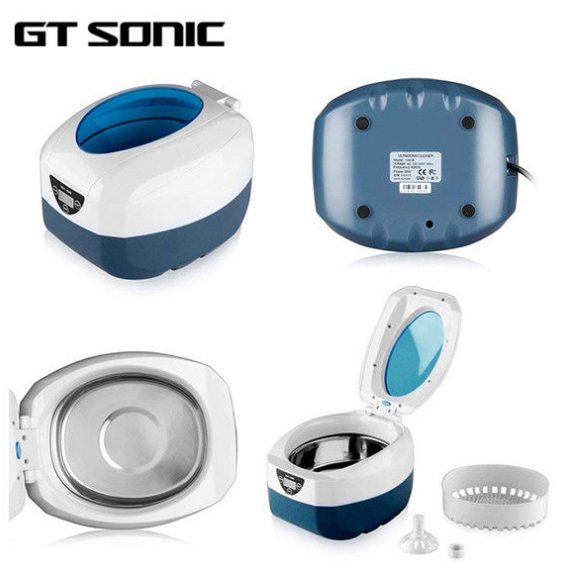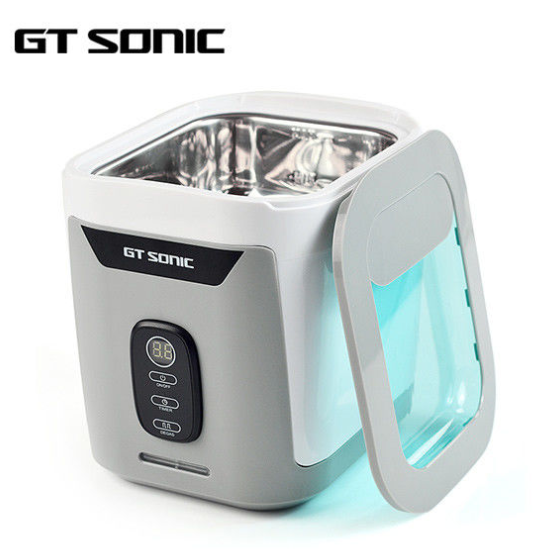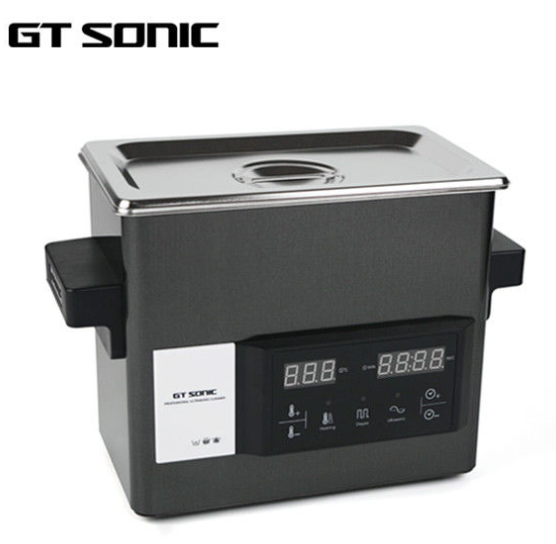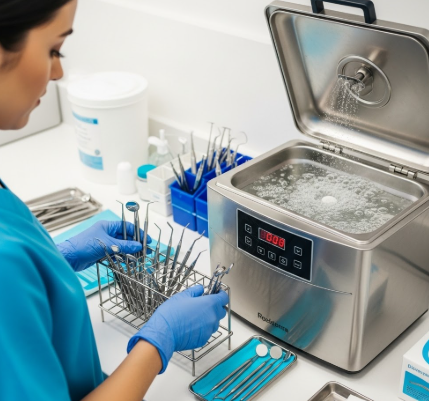GTSONIC Ultrasonic Cleaner for Dental Instruments: Ideal for Clinics and Laboratories
2025-11-12
This blog explores the technology behind ultrasonic cleaners, their benefits, and why the GTSONIC Ultrasonic Cleaner for Dental Instruments is the ideal choice for dental professionals.
In the fast-paced world of dental clinics and laboratories, maintaining cleanliness and hygiene of dental instruments is of utmost importance. According to Infection Control Today, ultrasonic cleaning is one of the most effective methods for sanitizing dental tools. This blog explores the technology behind ultrasonic cleaners, their benefits, and why the GTSONIC Ultrasonic Cleaner for Dental Instruments is the ideal choice for dental professionals. Whether you're setting up a new clinic or upgrading your existing equipment, this guide will help you make an informed decision.
What is an ultrasonic cleaner?
-How does an ultrasonic cleaner work?
-What are the benefits of ultrasonic cleaning?
What is an ultrasonic cleaner for dental instruments?
-Dental ultrasonic cleaner how it works
-How long to run ultrasonic cleaner for dental instruments?
-What is the benefit of using an ultrasonic cleaner for dental instruments?
Best ultrasonic cleaner for dental instruments:GT SONIC-S3 Digital Ultrasonic Cleaner
-ultrasonic cleaner dental equipment Product Description
-Ultrasonic Cleaner Dental Equipment Specifications
How to use ultrasonic cleaner for dental instruments?
What are the key features to look for when buying an ultrasonic cleaner?
What is an Ultrasonic Cleaner?

An ultrasonic cleaner is a device that uses high-frequency sound waves (ultrasonic waves) to clean objects. It works by generating sound waves that cause tiny bubbles to form and implode in a process called cavitation. This cavitation effect helps dislodge dirt, bacteria, and other contaminants from the surfaces of the objects being cleaned.
Ultrasonic cleaners are widely used in various industries, including dentistry, medicine, jewelry, and manufacturing. For dental clinics and laboratories, ultrasonic cleaners are particularly useful for cleaning dental instruments like scalers, handpieces, forceps, and mirrors. Their ability to thoroughly clean items without causing damage makes them a valuable tool in maintaining infection control and ensuring the longevity of dental instruments.
How Does an Ultrasonic Cleaner Work?
An ultrasonic cleaner works by transmitting high-frequency sound waves through a liquid, usually water or a specialized cleaning solution. These sound waves create rapid pressure changes that generate microscopic bubbles in the liquid. When these bubbles implode, they produce a tiny shockwave that scrubs away contaminants on the surface of the object.
The cavitation process is gentle but highly effective, allowing it to clean hard-to-reach areas, intricate designs, and fine details on dental instruments. The ultrasonic waves also work at a microscopic level, ensuring thorough cleaning, even of delicate components. This makes ultrasonic cleaning ideal for dental instruments, which require both precision and sanitation.
What Are the Benefits of Ultrasonic Cleaning?
Ultrasonic cleaning offers several advantages over traditional cleaning methods, particularly when it comes to dental instruments. Some of the key benefits include:
1.Deep Cleaning: Ultrasonic cleaners can reach into small crevices and intricate parts of dental instruments, ensuring that every part of the instrument is thoroughly cleaned, even those difficult-to-reach spots that manual cleaning can miss.
2.Time Efficiency: Ultrasonic cleaning is quick. Typically, the cleaning process only takes a few minutes, saving dental professionals time compared to manual scrubbing.
3.Non-Damaging: The process is gentle, reducing the risk of damage to delicate dental tools. Unlike scrubbing or using harsh chemicals, ultrasonic cleaning doesn’t wear down or distort instruments over time.
4.Effective Infection Control: Ultrasonic cleaners can remove not only visible dirt but also bacteria, biofilm, and other pathogens, making them an essential tool for maintaining a sterile environment in dental practices.
5.Eco-Friendly: Many ultrasonic cleaning solutions are water-based and biodegradable, reducing the need for harsh chemicals.
What is an Ultrasonic Cleaner for Dental Instruments?

A ultrasonic cleaner for dental instruments is a specialized device designed to clean dental tools and equipment using ultrasonic waves. These cleaners are specifically engineered to meet the stringent hygiene standards required in dental clinics and laboratories. They are equipped with features that cater to the needs of dental professionals, such as adjustable timers, temperature control, and specialized cleaning solutions that target the unique challenges of dental instrument cleaning.
Dental Ultrasonic Cleaner: How It Works
The mechanism of a dental ultrasonic cleaner is essentially the same as other ultrasonic cleaners. It uses high-frequency sound waves to create microscopic bubbles in a cleaning solution. As these bubbles collapse, they release energy that gently scrubs the surface of dental instruments. This process not only removes visible debris but also dislodges biofilms, bacteria, and other contaminants that may be hiding in hard-to-reach places, such as the small crevices of a dental scaler or handpiece.
The high-frequency sound waves are typically in the range of 25 to 45 kHz, which is the optimal frequency for removing contaminants from dental instruments. The ultrasonic waves penetrate deep into the instruments, thoroughly cleaning them without causing any damage.
How Long to Run Ultrasonic Cleaner for Dental Instruments?
The cleaning cycle duration for dental instruments typically lasts anywhere from 3 to 10 minutes, depending on the level of contamination and the type of equipment being cleaned. Dental ultrasonic cleaners usually come with adjustable timers, allowing the user to set the cleaning time based on the specific needs of the instruments.
It's important to note that longer cleaning cycles are not always better. Extended exposure to ultrasonic waves can lead to excessive wear or damage to delicate instruments. Therefore, it’s essential to follow the manufacturer's recommendations for optimal cleaning times.
What is the Benefit of Using an Ultrasonic Cleaner for Dental Instruments?
Using an ultrasonic cleaner for dental instruments provides several key advantages:
1.Consistency: Unlike manual cleaning, ultrasonic cleaning provides uniform results every time. Every surface of the instrument receives the same level of cleaning, ensuring no areas are missed.
2.Reduced Risk of Injury: Manual cleaning with sharp tools or brushes poses a risk of injury to dental staff. Ultrasonic cleaning eliminates this risk, as the cleaning process is automated and safe.
3.Increased Longevity of Instruments: By avoiding abrasive cleaning methods, ultrasonic cleaning helps extend the lifespan of dental instruments. Instruments are less likely to become worn down, corroded, or damaged over time.
4.Improved Infection Control: Ultrasonic cleaners effectively remove microbial contamination, reducing the risk of cross-contamination between patients.
Best Ultrasonic Cleaner for Dental Instruments: GT SONIC-S3 Digital Ultrasonic Cleaner

When it comes to ultrasonic cleaners for dental instruments, the GTSONIC-S3 Digital Ultrasonic Cleaner stands out as one of the best options available. This ultrasonic cleaner is designed with dental clinics and laboratories in mind, providing a powerful, efficient, and safe cleaning solution for dental instruments.
|
Item
|
Details
|
|
Place of Origin
|
Guangdong, China
|
|
Capacity
|
3L
|
|
Frequency
|
28kHz/40kHz
|
|
Voltage (V)
|
110.220V
|
|
Tank Capacity
|
3L
|
|
Supply Ability
|
100 Units Per Day
|
|
Certification
|
FCC, GS, RoHS
|
|
Warranty
|
1 Year
|
|
Material
|
ABS + Stainless Steel SUS304
|
|
High Light
|
Ultrasonic Digital Cleaner, Ultrasonic Instrument Cleaner
|
Ultrasonic Cleaner Dental Equipment Product Description
|
Specification
|
Details
|
|
Product Location
|
Guangdong, China
|
|
Capacity
|
3 Liters
|
|
Frequency
|
28 kHz / 40 kHz
|
|
Water Tank Capacity
|
3 Liters
|
|
Power Supply
|
110V / 220V
|
|
Certification
|
FCC, GS, RoHS
|
|
Warranty
|
1 Year
|
|
Material
|
ABS + SUS304 Stainless Steel
|
|
Supply Ability
|
100 Units per Day
|
|
Power
|
Ultrasonic Equipment Cleaner
|
The GTSONIC-S3 Digital Ultrasonic Cleaner is equipped with advanced ultrasonic technology to ensure thorough cleaning of dental tools and instruments. This model features a user-friendly digital control panel, allowing users to set precise cleaning times and temperatures. The sleek design and compact size make it easy to integrate into any dental practice, from small clinics to larger labs.
The cleaner's robust construction, featuring a stainless steel tank, ensures durability and resistance to corrosion. The GTSONIC-S3 also boasts a large tank capacity, making it suitable for cleaning multiple dental instruments at once.
Ultrasonic Cleaner Dental Equipment Specifications
|
Model
|
GT SONIC-S2
|
GT SONIC-S3
|
GT SONIC-S6
|
GT SONIC-S9
|
|
Tank Size (L×W×H)
|
150×140×100 mm
|
240×140×100 mm
|
300×150×150 mm
|
300×235×150 mm
|
|
Unit Size (L×W×H)
|
175×165×230 mm
|
330×165×230 mm
|
400×175×305 mm
|
400×265×305 mm
|
|
Body Material
|
2
|
3
|
6
|
9
|
|
Ultrasonic Power (W)
|
50
|
100
|
150
|
200
|
|
Ultrasonic Frequency (kHz)
|
40
|
40
|
40
|
40
|
|
Heating Power (W)
|
100
|
100
|
300
|
300
|
|
Timer (Minutes)
|
1-99
|
1-99
|
1-99
|
1-99
|
|
Heating Temperature (°C)
|
30-80
|
30-80
|
30-80
|
30-80
|
1.Frequency: 40 kHz for optimal cleaning of dental instruments.
2.Power Output: 120W for powerful cavitation and thorough cleaning.
3.Tank Capacity: 3L, ideal for both small and medium-sized dental practices.
4.Material: Stainless steel tank for durability and resistance to corrosion.
5.Control: Digital control panel with adjustable timer (up to 30 minutes) and temperature control (up to 80°C).
6.Safety Features: Overheat protection and automatic shut-off to ensure safe operation.
7.Noise Level: Low noise design for a quiet clinic environment.
8.Power Supply: Available in both 110V and 220V models, suitable for international use.
How to Use an Ultrasonic Cleaner for Dental Instruments?

Using an ultrasonic cleaner for dental instruments is simple and straightforward. Follow these steps for optimal results:
1.Prepare the Solution: Fill the tank with the recommended cleaning solution (water mixed with a dental instrument cleaner or disinfectant).
2.Load the Instruments: Place the dental instruments into the ultrasonic cleaner’s basket or tray to prevent them from touching each other.
3.Set the Time and Temperature: Adjust the cleaning time and temperature according to the manufacturer’s guidelines and the level of contamination.
4.Start the Cleaning Cycle: Turn on the ultrasonic cleaner and allow it to run for the set duration.
5.Rinse and Dry: After the cleaning cycle, remove the instruments and rinse them with clean water to remove any residue. Dry them thoroughly before storage or sterilization.
What Are the Key Features to Look for When Buying an Ultrasonic Cleaner?

When choosing an ultrasonic cleaner for dental instruments, consider the following features:
1.Frequency and Power: Ensure the ultrasonic cleaner has a frequency suitable for dental instruments (typically 40 kHz) and sufficient power for effective cleaning.
2.Tank Capacity: Choose a tank size that suits your practice’s needs. Larger capacities are ideal for cleaning multiple instruments at once.
3.Digital Controls: A digital control panel with adjustable settings for time and temperature offers greater precision and flexibility.
4.Durability: Look for a stainless steel tank for durability and resistance to corrosion.
5.Safety Features: Ensure the ultrasonic cleaner includes safety features such as overheat protection and automatic shut-off.
Conclusion
The GTSONIC Ultrasonic Cleaner for Dental Instruments offers an efficient, reliable, and safe solution for cleaning dental tools. With its advanced technology, user-friendly controls, and robust design, it is an excellent choice for dental clinics and laboratories looking to maintain the highest standards of hygiene. By investing in an ultrasonic cleaner, dental professionals can ensure thorough cleaning, improve infection control, and extend the lifespan of their valuable instruments.
Recommended reading
1.Top 5 Best Ultrasonic Cleaners for Dental Instruments: Effective Cleaning Solutions
2.Why Choose the GT-X3 Ultrasonic Dental Cleaner for Your Practice
3.How to clean your mouth guard: Ultrasonic denture cleaner VS. Denture cleaning table










